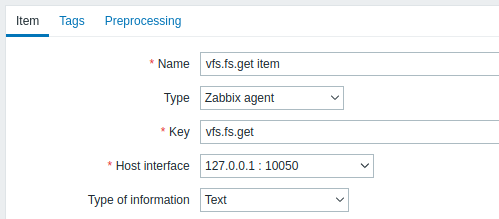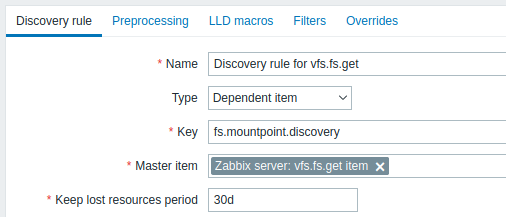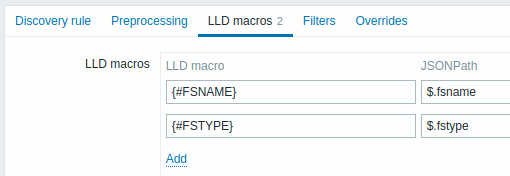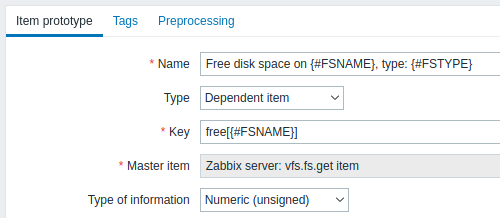1 Descubrimiento de sistemas de archivos montados
Descripción general
Es posible descubrir sistemas de archivos montados y sus propiedades. (nombre del punto de montaje, tipo de sistema de archivos, tamaño del sistema de archivos e inodo Estadísticas).
Para hacer eso, puede usar una combinación de:
- el elemento del agente
vfs.fs.getcomo elemento maestro - regla de descubrimiento de bajo nivel dependiente y prototipos de elementos
Configuración
Elemento maestro
Cree un elemento de agente Zabbix usando la siguiente clave:

Establezca el tipo de información en "Texto" para datos JSON posiblemente grandes.
Los datos devueltos por este elemento contendrán algo como lo siguiente para un sistema de archivos montado:
{
"fsname": "/",
"fstype": "rootfs",
"bytes": {
"total": 1000,
"gratis": 500,
"usado": 500,
"libre": 50,00,
"pused": 50.00
},
"inodos": {
"total": 1000,
"gratis": 500,
"usado": 500,
"libre": 50,00,
"pused": 50.00
}
}Regla LLD dependiente
Cree una regla de descubrimiento de bajo nivel como tipo "Elemento dependiente":

Como elemento maestro, seleccione el elemento vfs.fs.get que creamos.
En la pestaña "Macros LLD" defina macros personalizadas con el correspondiente Ruta JSON:

Prototipo de métrica dependiente
Cree un prototipo de métrica con el tipo "Métrica dependiente" en esta regla LLD. Como métrica principal para este prototipo, seleccione la métrica vfs.fs.get que creamos.

Tenga en cuenta el uso de macros personalizadas en el nombre y la clave del prototipo de la métrica:
- Nombre: Espacio libre en disco en {#FSNAME}, tipo: {#FSTYPE}
- Clave: Free[{#FSNAME}]
Como tipo de información utilice:
- Numérico (sin signo) para métricas como "free", "total", "used"
- Numérico (flotante) para métricas como 'pfree', 'pused' (porcentaje)
En la pestaña "Preprocesamiento" del prototipo de la métrica, seleccione JSONPath y use la siguiente expresión JSONPath como parámetro:

Cuando comience el descubrimiento, se creará una métrica por cada punto de montaje. Esta métrica devolverá la cantidad de bytes libres para el punto de montaje dado.

